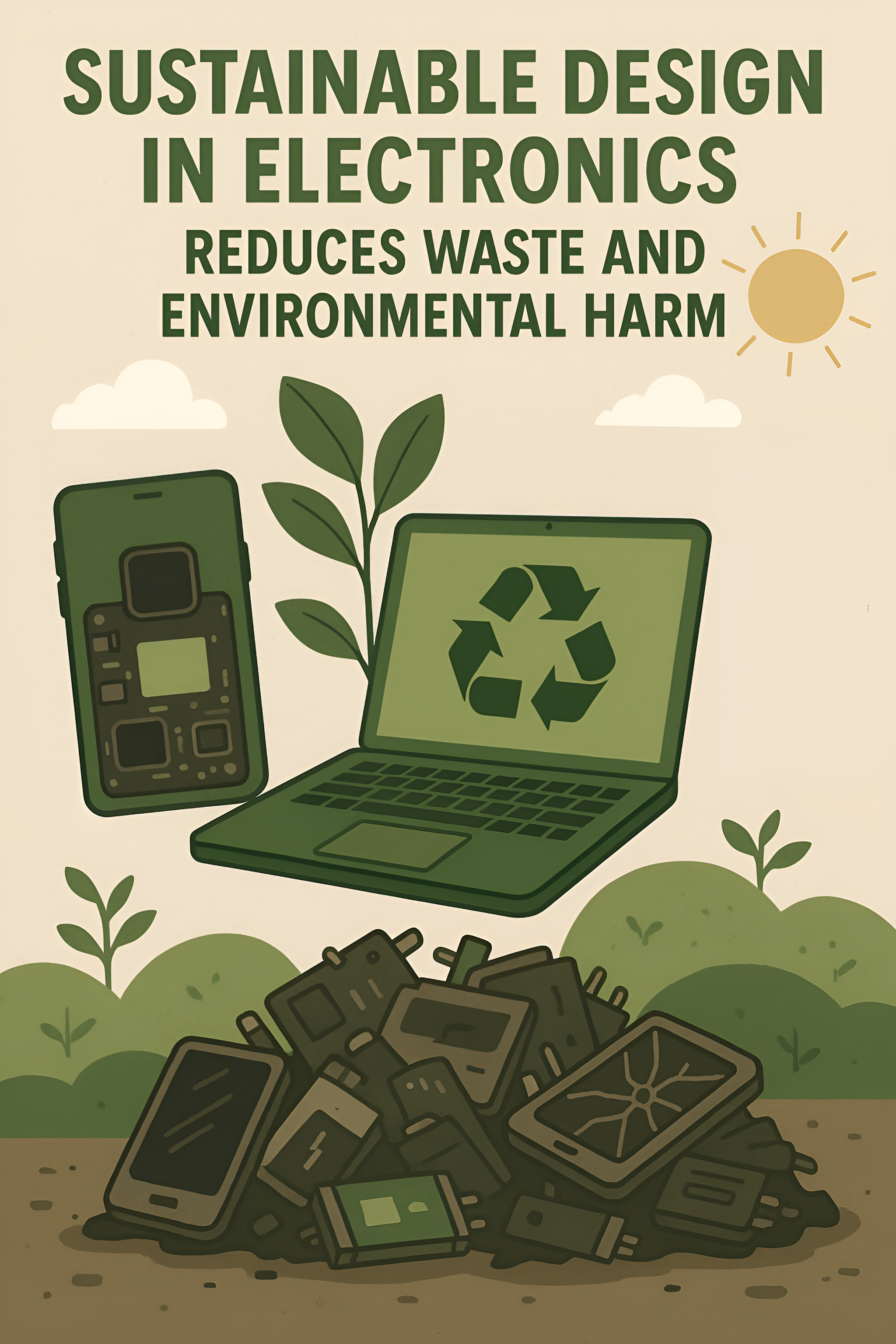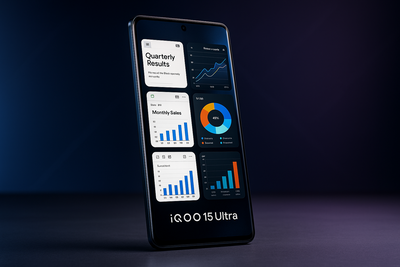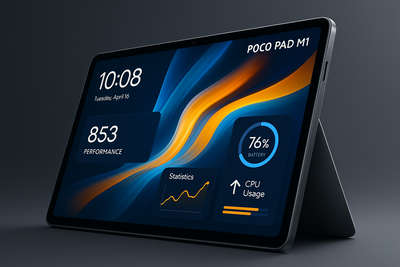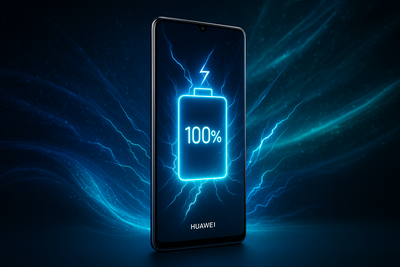Introduction: Why Sustainable Design Matters in Electronics
The world is producing more electronic devices than ever before. New products, ranging from smartphones to laptops, are released annually. However, with every new edition, the previous ones are disposed of. This leads to growing E-waste and damage to the environment. Sustainable waste management is a growing need. Sustainable waste management in electronics helps decrease pollution and protect our planet. Designers currently focus on sustainable materials and product durability. By reducing E-waste, we reduce health risks and resource losses. Green waste solutions are the future of tech. It is time we transform how electronics are made and disposed of.
Eco-Friendly Materials Reduce E-Waste Impact
A great move towards reducing E-waste is using green materials. The majority of electronic devices contain harmful chemicals like lead and mercury. These toxins make E-waste dangerous to humans and nature. By employing green materials, we minimize the damage caused by waste electronics. Green waste practice involves the usage of recyclable plastic and biodegradable materials. Such materials safely break down and reduce the volume of E-waste. Products made with safe materials are gentler on the planet. Green materials are a vital part of any green waste plan. Electronics made in this manner create less E-waste down the road.
-
Biodegradable Materials: Use of biodegradable components cuts down long-term pollution from electronics.
-
Toxic-Free Components: Avoiding harmful chemicals (like lead or mercury) makes disposal safer and greener.
-
Improved Recyclability: Eco-friendly materials are easier to separate and recycle, minimizing sustainable waste.
-
Supports Circular Economy: Encourages reuse and repurposing of parts, reducing environmental harm.
-
Lower Carbon Footprint: Sustainable materials require less energy to produce, reducing the overall ecological impact.
-
Extended Product Life: Durable, eco-safe materials make electronics last longer, decreasing E-waste over time.
- Fonezone's Role: Brands like Fonezone such materials through refurbished, responsibly sourced electronics.
Longer Lifespan Means Less E-Waste
The majority of electronics have a fast replacement cycle because of design failure or planned obsolescence. This cycle contributes to the mounting E-waste problem. Sustainable waste solutions aim to lengthen the lifespan of electronic devices. By creating more durable components, devices can survive longer. This translates to fewer devices ending up as E-waste. Companies now provide easily repairable devices. Such repairs discourage individuals from disposing of functional items. It assists sustainable waste objectives by reducing production requirements. It also minimizes the environmental impact of each product. If electronics are durable, we all generate less E-waste.
Modular Design Helps Reduce Electronic Waste
A modular design is a great concept in new electronics. It makes it easy for users to replace or upgrade components without having to discard the entire device. This assists in E-waste reduction. A faulty battery or display should not render the entire phone obsolete. Modular products facilitate sustainable waste management. They make repair and recycling simple and cheaper. Modular systems are being utilized by most technology companies now in phones, laptops, and accessories. The design makes it simpler to recycle electronics even after years of usage. E-waste is reduced because devices are not disposed of more frequently. Modular thinking is a successful approach for sustainable waste management.
Energy-Efficient Electronics Reduce Environmental Harm
Energy consumption is the invisible part of the electronics story. Energy-wasting products also harm the environment. Environmentally friendly waste design means creating electronics that use less energy. These devices run longer with less power and are good for the environment. Low-power devices also create less E-waste because they last longer. Companies now include power-saving modes and smarter power management. This lowers carbon emissions and lessens power demand. Eco-friendly waste design is not just recycling—it is also more effective energy use. Energy conservation reduces the effect of E-waste on the environment.
Better Recycling Systems Control E-Waste Growth
Recycling is the key to managing the mounting amount of E-waste. The majority of devices contain valuable elements like gold, copper, and silver. If they are recycled, we don't need to mine as much. Eco-friendly waste management includes the design of devices that are easy to disassemble. This is recycling and making it safer and more efficient. Improved E-waste systems and legislation are what most countries prefer now. Manufacturers are asked to take back old equipment and recycle it. This encourages consumers to have cleaner habits. Recycling as a form of environmentally friendly waste management makes E-waste an asset, not a threat. Fonezone believes in keeping devices running instead of dumping them. Extending the life of electronics is a great way of fighting sustainable waste and managing toxic E-waste. It is also cost-saving to the users and the environment.
-
Efficient recycling reduces the volume of harmful E-waste in landfills.
-
Sorting systems help separate reusable and toxic parts quickly.
-
Advanced technology makes recycling faster and more cost-effective.
-
Government policies and rules support proper E-waste management.
-
Public awareness campaigns encourage responsible disposal.
-
Incentive programs motivate people to recycle old electronics.
-
Brands like Fonezone E-waste recycling and refurbishing.
-
Certified centers ensure safe handling of electronic waste.
-
Recycled materials can be reused in new electronics.
- Better systems help reduce environmental harm and save resources.
Sustainable Packaging Supports Environmental Goals
The majority of electronics contain excessive packaging. Boxes are made of plastic or non-recyclable materials. Sustainable waste principles also address packaging. Corporates nowadays use cardboard, paper pulp, and plant-based materials. They minimize E-waste at the packaging stage. Green packaging is part of a complete green strategy. It indicates that the company is interested in more than the product. Sustainable waste consideration packaging is simpler to recycle and dispose of. This also prevents garbage from reaching the landfills. E-waste management starts even before the device is powered on.
Consumer Awareness Leads to Better Choices
Consumers have an important role to play to minimize E-waste. The majority are still oblivious to how toxic old electronics are. Green waste awareness causes people to make more intelligent buying and disposal choices. When people know the risks, they buy products with greener features. They may even recycle or donate equipment instead of throwing it away. Schools, companies, and governments must spread the word about E-waste problems. Knowledge is power, and it moves people to take concrete action. The more individuals are aware, the more we collectively endorse sustainable waste objectives. With Fonezone, individuals can minimize sustainable waste and make intelligent decisions for the planet.
Tech Companies Must Take Responsibility
Consumers have a significant part to play in minimizing E-waste. Most of them still are not aware of the extent of harm caused by old electronics. Sustainable waste education makes individuals make improved purchasing and disposal decisions. When individuals are aware of the hazards, they purchase products with more environmentally friendly features. They can also recycle or donate devices instead of throwing them away. Governments, schools, and companies must spread the word about E-waste problems. Knowledge is power, and it makes people make real change. The more you learn, the more we all encourage sustainable waste goals together. With Fonezone, you can reduce sustainable waste and make smart choices for the planet.
Conclusion: A Greener Future Through Sustainable Design
Big tech companies can lead the way. They must follow sustainable waste laws and invest in green design. Some already offer trade-in programs and recycled products. These measures manage the E-waste problem. Companies must publish reports on reducing waste. This generates trust and shows concrete progress. Governments can also pass laws that push companies towards sustainable waste. When big players take action, the effect is felt globally. They can change how we see and handle E-waste as a society. The planet cannot close its eyes to the growing problem of E-waste. We must act now with smart design and better practices. Sustainable electronic waste contains concrete answers. From longer lifespans to modular parts, green-oriented thinking makes a real difference. Consumers, corporations, and governments all have a role to play. Less E-waste means less pollution, fewer health risks, and a sustainable tomorrow. By choosing eco-friendly waste management solutions, we are protecting nature and ourselves. Every action counts. It's time for electronics to be part of the solution and not the problem.
Frequently Asked Questions
Q.1. What is E-waste?
E-waste means discarded electronic devices like phones, computers or Laptops.
Q.2. How does sustainable design reduce waste?
It uses better materials and longer-lasting parts to reduce sustainable waste and pollution.
Q.3. Why is modular design important?
Modular design allows part upgrades without replacing the whole product, cutting down E-waste.
Q.4. Can packaging also cause E-waste?
Yes, non-recyclable packaging adds to sustainable waste if not properly managed.
Q.5. What can consumers do to help?
They can recycle old electronics, buy energy-saving devices, and support sustainable waste brands.






















